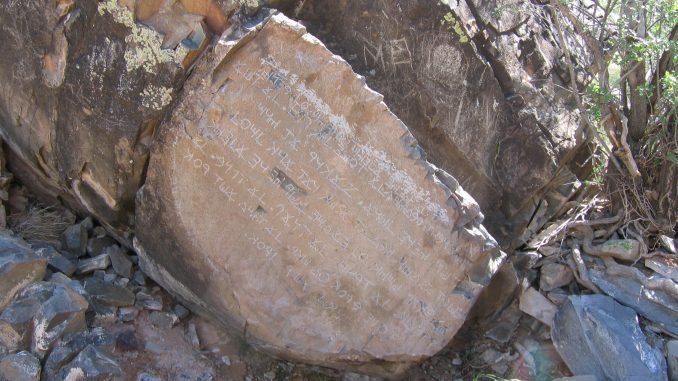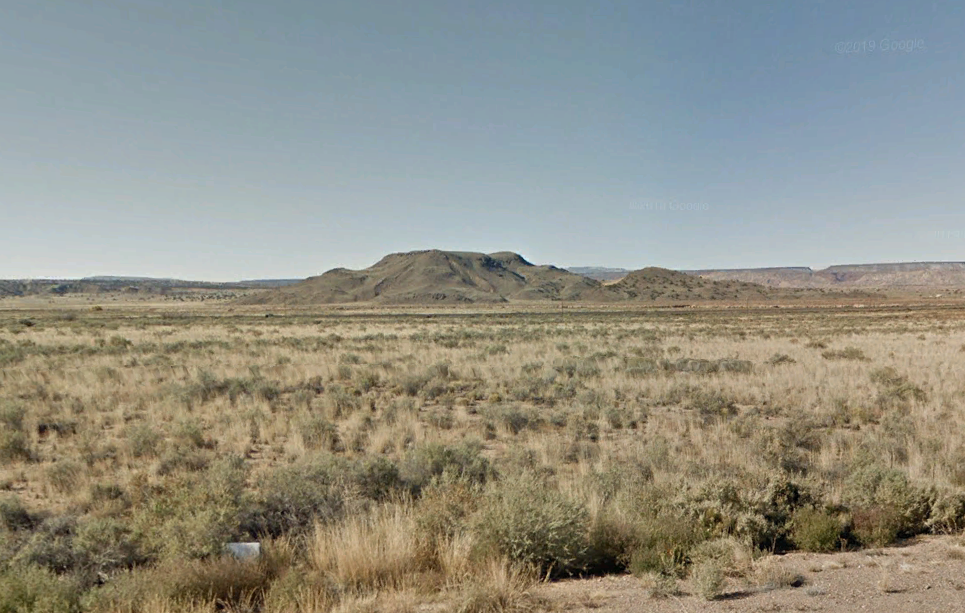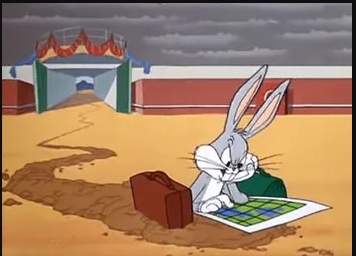
Where:
Los Lunas, New Mexico, approximately 36 miles south of Albuquerque, just off of historic Route 66. At the northeast edge of a volcanic remnant called Hidden Mountain. The site is on New Mexico State property and anyone that wants to visit needs a Rec Access Permit that costs about $35.
What:
A large basalt boulder of perhaps 80 tons, chiseled flat on one side and inscribed with 9 lines of text. The language of the text is apparently Hebrew and most translations agree that the text is a representation of the ten commandments of Exodus 20:2-17. Or a Decalogue. The boulder is also referred to as the “Mystery Stone” by some.
When:
The stone was first made public in 1936 though some sources state the discoverer, Frank Hibben, first located it in 1933. But the earliest written account of the stone dates to 1936. Hibben, however, claimed that he was taken to the site in 1933 by someone who remembered it as a boy in the 1880s.
Who:
Frank Hibben (1910-2002), a professor of archaeology from the University of New Mexico was the first to make the stone public. Hibben is something of a controversy at UNM and is used as an example in classes on how not to do archaeology. Apparently Hibben wasn’t beyond tweaking the data here and there to make it look good. In the past 2-3 decades, Hibben’s research has come into question often through publications that dispute claims like that of the Sandia Cave, where Hibbens claimed to find undisturbed sediments dating to 25,000 years ago that showed human occupation.
The Sandia claim was discredited by Haynes and Agogino who concluded that the points found in the cave were “definitely less than 14,000 years old. ” And in the 1970s, Hibben’s claim of Folsom points at a site in Chinitna Bay, Alaska was also shown to be false.
George E. Morehouse (some spellings are Moorehouse) ( ? ), a professional geologist in the mining industry. Examined the stone in the 1980s and described it in geologic terms as well as making an age determination of the text based on its features. Morehouse wrote about it in a newsletter for a club of amateur epigraphers that lean heavily toward pseudoscience and pseudoarchaeology.
Cyrus Gordon (1909 – 2001), a scholar of Near Eastern languages and culture. He examined the Los Lunas Stone early on and came up with a hypothesis.
Barry Fell (1917 – 1994), a professor of zoology and amateur epigrapher who was an expert on starfish and sea urchins but best known for his work in the world of pseudoarchaeology. Specifically, he argued that the Americas were visited by all sorts of Old World travelers long before Columbus ever set sail. He based this on his “translations” of ancient writings found in the Americas, the majority of which were fakes, frauds, and hoaxes.
James D. Tabor (1946- ), a biblical scholar and sometime proponent of pseudoarchaeological ideas (James ossuary, Jesus tomb…) interviewed Hibbens in 1996 and believes “ancient Israelites explored and settled in the New World in the centuries before the Common Era.”
The Claim(s):

text before the first line was vandalized in 2006.
The claim is that the stone has a paleo-Hebrew inscription which was created in or prior to the 1800s. The script is related to that of the Phoenicians, which was only known to scholars by 1870. Morehouse estimated the age of the text to be between 500 and 2000 years old based on patination and the orientation and position of the stone. He judged that the stone wouldn’t have originally been at the current 40 degree forward tilt but rather perpendicular to the ground and this sort of settling would take time and he claimed to measure the desert varnish and patina versus the polish created by wind-blown sand, thus the 500-2000 year range.
Barry Fell, pointed out that the stone was regularly cleaned by Boy Scouts, keeping the inscription “fresh” and free of lichen, so any measurement of patina needs to consider this. Fell also claimed in a different issue of the same newsletter Morehouse wrote for that the punctuation of the text matches that of ancient inscriptions even though other researchers argued that there were significant stylistic and grammatical errors.
Cyrus Gordon concluded that the stone was a mezuzah, normally a scroll or parchment in a small case or container adorned with Hebrew writing, symbols, or letters and mounted to doorways and entrances. Inside are writings from the Torah. Together this is believed to have an anti-demonic function or will ward off evil. Gordon claimed this was a Samaritan version, which, in antiquity, was often a large stone slab at gateway or synagogue entrance and he placed the origin of the stone in the Byzantine period (395 – 1453 CE).
James Tabor stated that he has, “become tentatively convinced that the Los Lunas inscription offers solid evidence that ancient Israelites explored and settled in the New World in the centuries before the Common Era.”
In short, the more grandiose claims are that the stone was created by ancient Near Eastern people who traveled to the middle of no where in New Mexico to carve a stone with the ten commandments. Well before European colonization of the Americas.
The Scoop:
The short version is: this is almost certainly a modern work created between 1870 and 1936.
The notion of ancient Israelites finding their way to the middle of New Mexico, wrong turns at Albuquerque notwithstanding, is a little far-fetched. But let’s look at the evidence:
First, there is no archaeological context. No nearby Israelite settlements, encampments, or villages. In fact, none in the Americas at all! Proponents will say, “no one has excavated at the stone so how would they know?” In some ways, this is a fair point. But archaeologists don’t just excavate willy-nilly. They look for tell-tale signs of settlements first: bits of broken pottery, tells or mounds, the results of shovel testing, local informant information, etc. If none of these indicators are present and if there isn’t much topsoil to bury remnants of the past, there isn’t much reason to do a costly and probably fruitless excavation.
Second, Frank Hibben created for himself some issues of trust when it comes to his word about archaeological sites. Did he create the stone? Did he know who did? We will probably never know.
Third, George E. Morehouse’s work has some problems. His expertise in the study of desert varnish and dating the patina of rock art is worth questioning. His expertise was in mining and the geology associated with mining. But in the best of circumstances, dating rock art through examination of patina and desert varnish is fickle or even capricious. And, in the case of the Los Lunes stone, it was established that Boy Scouts regularly cleaned it. Patina and varnish? Forget about it. And the positioning of the stone? New Mexico has a history of earthquakes. Or maybe it was just carved that way. If you show me some work Morehouse did on rock art patina and desert varnish elsewhere, I might have a different opinion.
Fourth, Barry Fell. I really don’t have to say more than this. Fell has been thoroughly and mercilessly critiqued and debunked over the years. His “translations” have been shown to be sloppy amateurish at best. But this is what he was: an amateur. He was no doubt a brilliant marine biologist or zoologist, but no more a linguist and epigrapher than I am a watchmaker (I do dabble in horology, by the way).
Finally, there’s a very detailed analysis of the Los Lunes stone by Mark Perkins and Titus Kennedy that really picks apart the text itself. They find some faults with Gordon’s assumptions along with those of others, and noted that Tabor proclaimed the stone of great age but offered no analysis. Perkins and Kennedy, however, offer a detailed analysis that is literally line-by-line and character-by-character.
Perkins and Kennedy conclude that the inscription was created after the rediscovery of the Phoenician script (late 19th Century CE). They also concluded that it was made using modern tools and that the creator had “limited or no knowledge of Hebrew. Click the link above to read their work and how they arrived at these conclusions.


While always skeptical of such claims without provenance, I question if we should use the bad reputations of later pundits as evidence against the validity of the inscription. Yes, certainly Frank Hibben’s other sketchy (or downright bad) claims are good evidence against the validity of this find, but the questionable nature of others who jumped ion the bandwagon shouldn’t make any difference one way or another. And, yes, we should reject the support these later fraudsters provided. I’m asking this in good faith and in no way to argue in support of this inscription. To me, the most valid evidence against this inscription being supportable is the lack of archaeological context and also Frank Hibben’s other questionable claims.
If the reputation of a pundit is bad enough to question their legitimacy as a pundit, then it’s fair game.